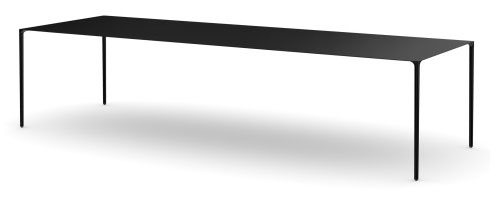Super-thin table?
December 18, 2008 at 2:58 PM by Dr. Drang
This item at BoingBoing Gadgets caught my eye. It’s about a table constructed of carbon fiber.
The “Surface Table” by John Barnard and Terence Woodgate is three-meters long — and just two-millimeters thick, due to its construction from carbon fiber.

Carbon fiber composites are wonderful materials, but my first impression was that such a table would be way too flexible to be anything but a conversation piece. But since impressions mean very little, let’s do a little structural analysis.
The table is basically a simply-supported beam. The deflection of a simply-supported beam under a concentrated load at its center is
where is the deflection, P is the load, E is the modulus of elasticity, and I is the cross-sectional moment of inertia. The moment of inertia can be determined through the formula
where b is the width of the table and h is the thickness. Plugging this into the formula for the deflection, and doing a little algebra, we get
The table is said to be 3 meters long and 2 millimeters thick, so . Based on the photo, I would judge the width of the table to be about 750 mm.
The modulus of elasticity will depend on the type of carbon fiber used, the arrangement of the fibers, and the matrix into which the fibers are laid. I’m no carbon fiber expert, but it appears from sites like this that the modulus is unlikely to be more than 500 GPa. One gigapascal is , so we’ll assume .
So
which means that the table, as described, will deflect over 2 mm for every newton1 of load placed at its center. That’s way too flexible.
It’s possible that my estimate of the table’s width is low, but increasing the value of the width won’t change the stiffness dramatically because the stiffness varies directly with the width. Big stiffness changes will only come with changes in the thickness; the stiffness varies with the cube of the thickness.
My guess—and there’s a suspicion of this in the BB Gadgets item, too— is that the table is thicker at the center. If we assume a 5 mm thickness over most of the interior of the table, the center will deflect 0.144 mm per newton—stiff enough to carry a few light items without looking like a hammock.
The equations on this page are being rendered by jsMath, a wonderful JavaScript library, that allows math to be displayed in browsers, like Safari, without MathML support. If you don’t have TeX fonts on your computer, you may find the equation display a little flaky or slow. These directions will lead you to the fonts.
You should see a little “jsMath” rectangle in the lower right corner of your browser window. Clicking on it will pop up a window that lets you adjust several jsMath settings, including the size of the math symbols. I prefer a 110% scale factor.
If you’re viewing this in an RSS reader, I’m not sure what you’ll see, but my guess is that you’ll get the raw LaTeX used to describe the equations. (Update [12/19/08]: This turned out to be a good guess—I saw LaTeX code in NetNewsWire.) If so, you’ll have to visit my site directly to see the rendered equations. This isn’t link bait—I don’t have any ads.
-
A newton, for those of you unfamiliar with the unit, is less than a quarter of a pound. It’s defined as the force necessary to accelerate a one kilogram mass at one meter per second squared. ↩
